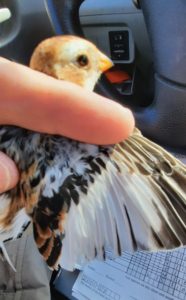My Grandmother was a fount of “useful” information and adages. Several continue to live with me and I particularly like this one: “patience is a virtue, professed by many, possessed by few”. And it was going through my mind as, sitting in my car at the edge of a prospective bunting field, I watched as time and again flocks of Horned Larks swept into the trap area to look over the cut corn bait and then whirled away. Sometimes they circled over the field and returned and sometimes they just kept going.
Horned Larks play a pivotal role in my catching of Snow Buntings. They seem to quickly find bait piles that I put out and will return to them day after day as long as I keep replenishing them. Snow Buntings range widely over the landscape, always on the lookout for feeding birds and when snow is on the ground the larks stand out. The buntings are quick to move in to see what is available.
I was kind of excited when I learned that the forecast for the last part of January was going to be cold with a chance of snow – the two conditions that are required to catch Snow Buntings down here. I had been baiting this field for about 10 days in anticipation and today (with yesterday’s snow) it paid off.

The wide white edging to the greater secondary coverts indicates that this female is “older”; i.e., hatched previous to 2020. -DOL
Horned Larks were in attendance at the site all morning. The single largest count I got was 28 but when these would fly off others would take their place – it was difficult to make out whether the “new” birds were part of this 28 or different ones; probably a little of both. Due to the cold they were keen to get at the corn and, consequently, I caught and banded 5 of them. But the important thing (not to say that the larks aren’t important) is that they attracted 4 Snow Buntings: a group of 3 and then a single bird. I caught the latter – it turned out to be an “older” female (i.e., hatched prior to 2020). Hopefully more will show up tomorrow as it is supposed to stay well below freezing for a few days.
Rick


